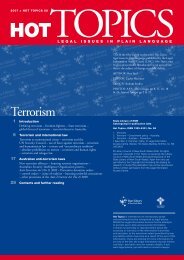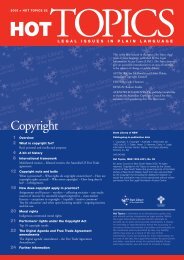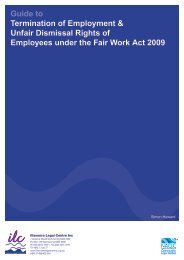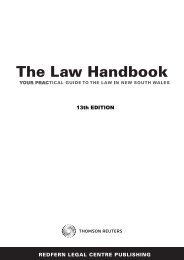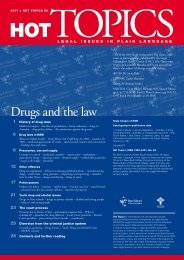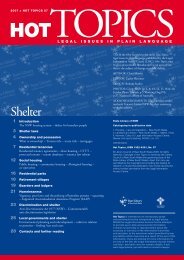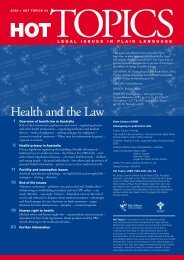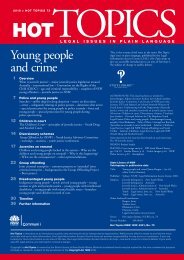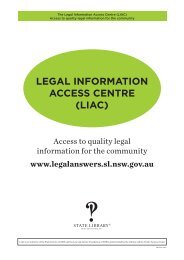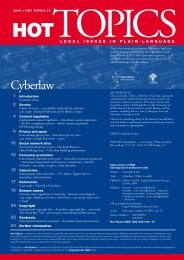Aboriginal people and the law - Legal Information Access Centre
Aboriginal people and the law - Legal Information Access Centre
Aboriginal people and the law - Legal Information Access Centre
You also want an ePaper? Increase the reach of your titles
YUMPU automatically turns print PDFs into web optimized ePapers that Google loves.
70 The Law H<strong>and</strong>book[2.510] Copyright <strong>law</strong> <strong>and</strong>Indigenous cultural <strong>and</strong>intellectual propertyRecognising communal rightsYumbulul v Reserve Bank of Australia (1991) 21IPR 481 concerned a morning star pole, afunerary object created by Mr Yumbululunder <strong>the</strong> authority given to him as amember of <strong>the</strong> Galpu clan group. The polewas sold to <strong>the</strong> Australian Museum forpublic display, a permissible use to educate<strong>the</strong> wider community about <strong>Aboriginal</strong>culture.However, Mr Yumbulul licensed reproductionrights to <strong>the</strong> <strong>Aboriginal</strong> ArtistsAgency, which subsequently approved <strong>the</strong>Reserve Bank reproducing <strong>the</strong> pole on <strong>the</strong>bicentennial $10 note. Mr Yumbulul wascriticised by his community for exceedinghis authority under customary <strong>law</strong>s. Accordingto <strong>the</strong> traditional custodians, it wasnot culturally appropriate for such a sacreditem to be reproduced on money. Mr Yumbululinitiated action in <strong>the</strong> Federal Court,alleging that he would not have authorised<strong>the</strong> licence to <strong>the</strong> <strong>Aboriginal</strong> Artists Agency<strong>and</strong> <strong>the</strong> Reserve Bank had he fully understoodit.While finding that Mr Yumbulul mistakenlybelieved <strong>the</strong> licence would imposelimitations on <strong>the</strong> use of <strong>the</strong> pole similar tothose in <strong>Aboriginal</strong> customary <strong>law</strong>, <strong>the</strong> courtconsidered that “Australia’s copyright <strong>law</strong>does not provide adequate recognition of<strong>Aboriginal</strong> community claims to regulate<strong>the</strong> reproduction <strong>and</strong> use of works whichare essentially communal in origin”.Unauthorised reproduction of artworksIn Milpurrurru v Indofurn Pty Ltd (1993) 130ALR 659, <strong>the</strong> court discussed copyrightinfringement of Indigenous artworks of culturalsignificance to <strong>the</strong> artist applicants <strong>and</strong><strong>the</strong> cultural groups to which <strong>the</strong>y belonged.The case involved <strong>the</strong> unauthorised reproductionof Indigenous artworks on carpetsmade in Vietnam <strong>and</strong> imported intoAustralia. Significant aspects of <strong>the</strong> caseincluded <strong>the</strong> following:• a work may be original if <strong>the</strong>re is sufficientdetail <strong>and</strong> complexity reflecting skill<strong>and</strong> originality, even if it is based ontraditional designs• though not identical to <strong>the</strong> originalartworks, <strong>the</strong> carpets reproduced centrallyimportant parts. For example, <strong>the</strong>part taken from Tim Payunka Tjapangati’spainting Kangaroo <strong>and</strong> Shield PeopleDreaming depicted a sacred men’s story –one factor that led <strong>the</strong> court to concludecopyright had been infringed• part of <strong>the</strong> $188,000 awarded in damageswas given in consideration of <strong>the</strong> personalhurt <strong>and</strong> cultural harm done to <strong>the</strong>artists. The court noted that <strong>the</strong>ir st<strong>and</strong>ingin <strong>the</strong> community could be affectedbecause of <strong>the</strong> culturally offensive misuseof <strong>the</strong> works, regardless of whe<strong>the</strong>r <strong>the</strong>yhad authorised it.The court made a collective award to <strong>the</strong>artists ra<strong>the</strong>r than individual awards so that<strong>the</strong>y could distribute it according to <strong>the</strong>ircultural practices.Collective ownership of artworksIn Bulun Bulun v R & T Textiles Pty Ltd (1998)157 ALR 193, <strong>the</strong> Federal Court discussedissues of collective ownership <strong>and</strong> communalcopyright. John Bulun Bulun’s workMagpie Geese <strong>and</strong> Water Lilies at <strong>the</strong> Waterholehad been reproduced on fabric importedinto Australia by R & T Textiles. Therespondents conceded that Mr Bulun Bulunwas <strong>the</strong> copyright owner <strong>and</strong> reached asettlement with him, leaving <strong>the</strong> court toconsider only <strong>the</strong> claims <strong>the</strong> second applicantGeorge M (since deceased) brought as<strong>the</strong> representative of <strong>the</strong> Ganalbingu <strong>people</strong>.Those claims asserted that <strong>the</strong> Indigenousowners of Ganalbingu country were <strong>the</strong>equitable owners of Mr Bulun Bulun’s copyrightin <strong>the</strong> work, which embodied imagerysacred <strong>and</strong> important to <strong>the</strong> Ganalbingu<strong>people</strong>’s cultural heritage.The Federal Court dismissed Mr M’sclaims. However, it offered some interestingcomments on <strong>the</strong> nature of Indigenouscultural heritage, including that:



